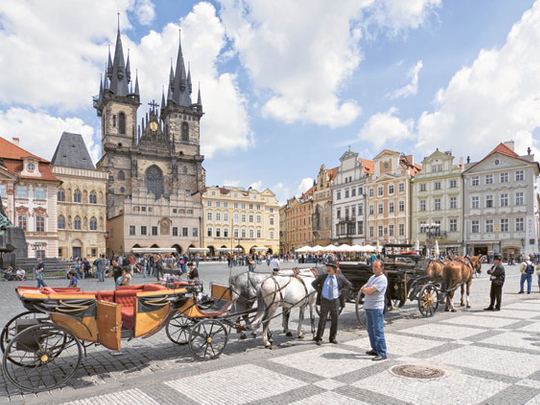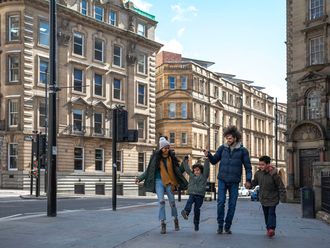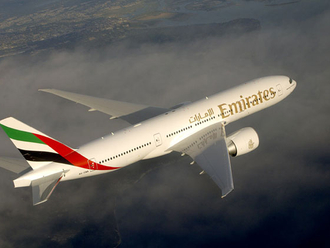
As a commemoration of something so significant, Prague's Museum of Communism isn't easy to find. The guidebooks might be adamant that it is just off Wenceslas Square on Prikope Street, but locals look bewildered when I ask.
In the end, I turn to a man in a tourist information booth. He thinks hard for a couple of minutes. "It's just up the road," he says eventually. "Above McDonald's, inside the casino." What would Marx have thought?
Bypassing McDonald's, I head upstairs. There's a plywood recreation of the Berlin Wall, a mocked-up Seventies classroom and a shop front, complete with a minimalist display of communist-era consumer goods, largely comprising packets of flour.
Another room has been recreated as a police interrogation room, with Fifties telephones and a rickety desk. It's hard to get away from the idea that the museum is the result of a Czech entrepreneur picking through a few skips and family attics. Then there are the loos. Falling apart, with no paper and an out-of-order sign propped up in the corner, they are either the work of someone trying to provide the ultimate experience of life behind the Iron Curtain or someone with no regard for their visitors' comfort.
All the glamour
I head outside to Coffee Heaven and travel 20 years in time just by crossing the road. This establishment, on a pedestrianised street full of shops and shoppers, represents the glossy new Prague, offering lattés, muffins and Wi-Fi — the ideal place to start a weekend romp through the Czech capital's communism-to-conspicuous consumption decades. I arrange to meet Helena, an acquaintance who has offered to show me around. "Let's meet by Cartier in the Old Town Square," she says. "You can't miss it."
She's right. The shop dominates one corner of this beautiful, pastel-coloured square. We head to Wenceslas Square where the dissident playwright Vaclav Havel led the Velvet Revolution in 1989. "That's the balcony he spoke from," says Helena, pointing to a branch of Marks & Spencer. Now a diamond dealer, Helena only shops at M&S for food, her fashion tastes being a bit upmarket for the trusty department store. In her late twenties, her memories of communism are dim.
Her parents weren't members of the Communist Party. "Only ten per cent of the population were," she says. She remembers consumer desirables being thin on the ground in her early childhood and recalls her best friend's father, a gymnastics coach, bringing his daughter a pair of Western jeans from a trip abroad. The girl slept with them under her pillow every night for more than a year. "I was so jealous," says Helena as we pass Louis Vuitton — fashion in Prague now aspires to the crystal-studded glitz end of the spectrum.
After the Velvet Revolution, Prague hit the tourist jackpot. Its 14th-century buildings, which survived the Second World War, give the city an air of romance to rival Paris. And thanks to the city's sense of bonhomie, there's a feeling that there's a perpetual freshers' week taking place. The giant statue of Stalin that used to loom over the city from Letna Park has been replaced by a huge metronome that a group of art students created as a joke in the early Nineties. "It doesn't actually work," says Helena, "probably on purpose." The official monument to communism is a statue underneath Petrin Hill, but it's difficult to decipher its symbolism. "It's meant to be a personality disintegrating under communism," says Helena, noting my expression.
But with communism dead it's not all glitz. Prague also has a peaceful and reflective side. Its newest luxury hotel, The Augustine, is as calm as you might expect from a premises partly created from a 13th-century monastery. Several friars still live in a separate part of the monastery, adjacent to the hotel's grounds. This may provide a serene influence but the hotel, with its 24-hour room service, spa and several bars, could hardly be described as monastic.
Hotel with a difference
However, it must be the only hotel in the world where you are prayed for after checking in. Father William greets us and, careful not to spoil the effect, fishes out a mobile phone from his austere brown habit to put it in silent mode. He takes us to see the monastery's library — a long, low room stacked with dusty, leather-bound books that are slowly being catalogued.
"Somewhere here," he says lightly, "is a first or second edition of Martin Luther's works." He takes us back to the hotel side, joining us for a cappuccino in Tom's Bar, which was once the monastery's refectory. "It's a lot more comfortable than it was in our day," says Father William. Call it guilt, but I'm finding the luxury a bit hard to take. Does he think that turning part of it into a luxury hotel was the right thing?
"What would you prefer? A faceless office building? There will never be enough monks to fill it again," he says. "We owned historic buildings but the roof was in danger of collapsing."
Communism has been airbrushed at The Augustine — instead the hotel, with its angular art and wide corridors, glories in the Twenties when Prague embraced the Modernist movement.
The original monks weren't above the occasional indulgence, it seems. Down in the vaulted cellars is another bar, specialising in a beverage that has been brewed there since 1352. Guests, however, can appreciate it another way. The hotel's spa offers the St Thomas' Body Forming Treatment.
My companion may have been non-plussed by the concept — "Will you smell like an old pub carpet?" — but it left me in good shape for a meal at one of Prague's finest restaurants, Kampa Park. Mick Jagger recently celebrated his birthday here. From revolution to rock 'n' roll, Prague has come a long way in 20 years.
FLY... Emirates: From Dubai Dh4,185
— Information courtesy the Holiday Lounge by Dnata. Ph: 04 3492886
Go There!
Prague, Czech Republic











